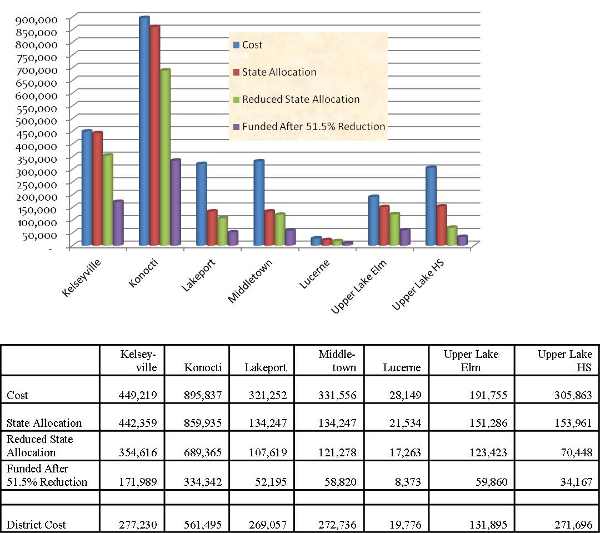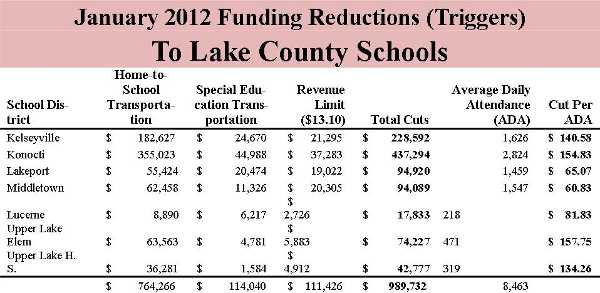- Lake County News reports
- Posted On
LCOE: Lake County schools brace for mid-year transportation cuts

LAKE COUNTY, Calif. – The Lake County Office of Education reported Tuesday that recently announced mid-year state budget cuts include massive and unequalled reductions to much-needed transportation funds for rural and small school districts.
As a result, Lake County Superintendent of Schools Wally Holbrook said Lake County school districts are again preparing to deal with more reductions to funding for education and schools.
This time, however, the proposed cuts are in the middle of the budget year, lack specificity and are based on disproportionate funding allocations for school districts that provide necessary but not mandated transportation, he said.
Holbrook said the Lake County schools revenue limit funding per-student has been reduced over the last five years by approximately $1,300 per-student, and local schools are now preparing for an additional $13.10 per student mid-year reduction.
In addition, transportation funding will be reduced by 51.5 percent, which Holbrook said will result in a loss of approximately $875,000 to Lake County schools.
The mid-year cuts in transportation raise many issues for Lake County’s schools, Holbrook said.
Lake County schools and parents rely heavily on home to school transportation – in the form of school buses – to get their children to school, Holbrook said. Due to the county’s geography and walking distances to school, a higher percentage of local students ride the bus.
While home to school transportation is not a state-mandated program, Holbrook said it is a critical service ensuring that students attend school on a regular basis, and average daily attendance (ADA) is the primary determiner for school funding. Simply discontinuing school transportation service is not a viable solution for Lake County schools.
Another issue raised is the apparent lack of fairness in how the reductions in transportation funds will be calculated, according to Holbrook.
The 51.5-percent reduction is planned to be applied in January to a decades-old base-funding appropriation that varies from district to district. Holbrook said the result of this approach will be a disproportionate reduction of dollars on a per-student basis.
According to the chart below, total Lake County reductions per-student will range from a low of $60 per-student to a high of $157, Holbrook said.
In addition, state transportation funds allocated to Lake County schools already have been reduced and do not fully cover the cost of providing transportation, Holbrook said.
In 2011-12 Lake County school transportation entitlements have been reduced by $435,000, thereby requiring local school districts to allocate more than $1,803,000 of scarce regular education dollars to maintain the current level of service, he said.
As an example, Kelseyville Unified School District’s initial transportation allotment was $442,359 and was reduced to $354,616 in July, Holbrook said. Now that allocation will be reduced again by 51.5 percent, leaving just $171,989 as the state funded amount.
Kelseyville’s regular education budget will now need to fund $277,230 of the total transportation costs, which Holbrook said amounts to $449,219.
Lastly, Holbrook said the timeline for implementation of mid-year reductions is problematic.
Schools cannot simply reduce personnel costs, he said.
Most, if not all, school districts are subject to collective bargaining agreements requiring them to adhere to strict procedures for notification and communication related to reducing staff, Holbrook said. In order to fairly and efficiently implement any reductions in staff, a minimum of 60 to 90 days is required, thereby reducing the potential savings in the remaining school year.
While it may be overly optimistic to expect that education would be held harmless from future cuts until the budget stabilizes, the reductions could be applied in a more equitable fashion, he said.
The same dollars generated in the 51.5 percent reduction to transportation could be achieved by a statewide “across the board” reduction of $42 per student, Holbrook suggested.
Holbrook is encouraging local parents to consider contacting Lake County’s state legislators to encourage them to quickly address this issue.
“Together we can make a difference,” Holbrook said.
Follow Lake County News on Twitter at http://twitter.com/LakeCoNews, on Tumblr at www.lakeconews.tumblr.com, on Google+, on Facebook at www.facebook.com/pages/Lake-County-News/143156775604?ref=mf and on YouTube at www.youtube.com/user/LakeCoNews .


 How to resolve AdBlock issue?
How to resolve AdBlock issue? 







